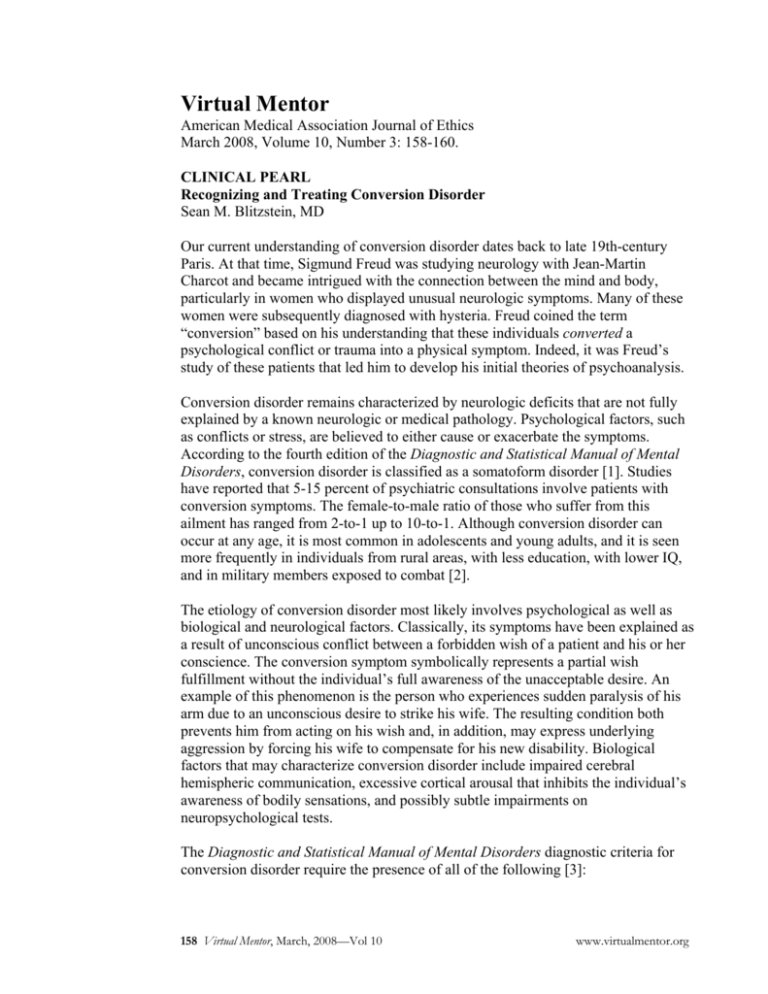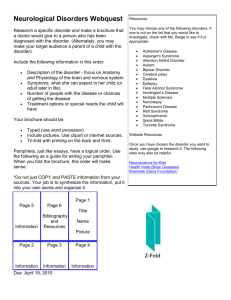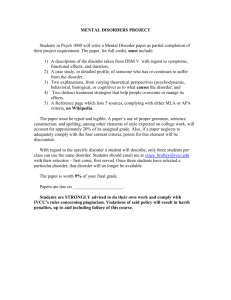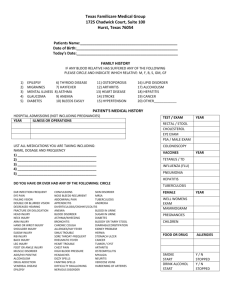
Virtual Mentor
American Medical Association Journal of Ethics
March 2008, Volume 10, Number 3: 158-160.
CLINICAL PEARL
Recognizing and Treating Conversion Disorder
Sean M. Blitzstein, MD
Our current understanding of conversion disorder dates back to late 19th-century
Paris. At that time, Sigmund Freud was studying neurology with Jean-Martin
Charcot and became intrigued with the connection between the mind and body,
particularly in women who displayed unusual neurologic symptoms. Many of these
women were subsequently diagnosed with hysteria. Freud coined the term
“conversion” based on his understanding that these individuals converted a
psychological conflict or trauma into a physical symptom. Indeed, it was Freud’s
study of these patients that led him to develop his initial theories of psychoanalysis.
Conversion disorder remains characterized by neurologic deficits that are not fully
explained by a known neurologic or medical pathology. Psychological factors, such
as conflicts or stress, are believed to either cause or exacerbate the symptoms.
According to the fourth edition of the Diagnostic and Statistical Manual of Mental
Disorders, conversion disorder is classified as a somatoform disorder [1]. Studies
have reported that 5-15 percent of psychiatric consultations involve patients with
conversion symptoms. The female-to-male ratio of those who suffer from this
ailment has ranged from 2-to-1 up to 10-to-1. Although conversion disorder can
occur at any age, it is most common in adolescents and young adults, and it is seen
more frequently in individuals from rural areas, with less education, with lower IQ,
and in military members exposed to combat [2].
The etiology of conversion disorder most likely involves psychological as well as
biological and neurological factors. Classically, its symptoms have been explained as
a result of unconscious conflict between a forbidden wish of a patient and his or her
conscience. The conversion symptom symbolically represents a partial wish
fulfillment without the individual’s full awareness of the unacceptable desire. An
example of this phenomenon is the person who experiences sudden paralysis of his
arm due to an unconscious desire to strike his wife. The resulting condition both
prevents him from acting on his wish and, in addition, may express underlying
aggression by forcing his wife to compensate for his new disability. Biological
factors that may characterize conversion disorder include impaired cerebral
hemispheric communication, excessive cortical arousal that inhibits the individual’s
awareness of bodily sensations, and possibly subtle impairments on
neuropsychological tests.
The Diagnostic and Statistical Manual of Mental Disorders diagnostic criteria for
conversion disorder require the presence of all of the following [3]:
158 Virtual Mentor, March, 2008—Vol 10
www.virtualmentor.org
A. One or more sensory or motor deficits suggesting a neurological condition;
B. Psychological factors (stressors or conflicts) associated with the initiation or
exacerbation of the symptom;
C. Symptoms not produced intentionally (as in factitious disorder or
malingering);
D. Symptoms not fully explained by a general medical condition, the effects of a
substance (medication or drug/alcohol), or a culturally sanctioned behavior;
E. Symptoms cause clinically significant distress or impairment of function;
F. Symptoms not limited to pain, sexual dysfunction, or part of somatization
disorder.
The most common deficits of conversion disorder are paralysis, blindness, and
mutism. Other common symptoms are anesthesias, paresthesias (particularly of the
extremities), deafness, abnormal movements, gait disturbances, weakness, tremors,
and seizures (so-called pseudoseizures). In all of the above, the presentation and
physical exam are not consistent with a known neurological, anatomical, or
physiological pathology. La belle indifference (the patient’s lack of concern
regarding the apparent magnitude of the deficit), once believed to be a hallmark of
conversion disorder, is not consistently present.
The most important and difficult step in treating conversion disorder is making the
correct diagnosis. Studies have found that 25-50 percent of patients diagnosed with
conversion disorder are eventually discovered to have a medical condition that could
have caused the symptoms. A thorough medical and neurologic workup is therefore
essential for patients with suspected conversion disorder. Pathologic conditions that
can look like conversion include brain tumors, multiple sclerosis, myasthenia gravis,
basal ganglia disease, optic neuritis, Guillain-Barre, Creutzfeldt-Jakob, and AIDS.
Somatization disorder may manifest with conversion characteristics, but patients
with the former have a chronic course with physical symptoms in multiple other
organ systems. Conversion disorder is often confused with both factitious disorder
and malingering. In factitious disorder, individuals consciously create illness as a
means to assume the sick role. Malingerers consciously fake symptoms or illness to
achieve secondary gain (e.g., avoidance of work, jail, or military duty or obtaining
compensation).
Psychiatric disorders that are often present with conversion disorder include
somatization and depressive, anxiety, and personality (particularly histrionic)
disorders. It is not uncommon for patients with a conversion disorder to actually
have some underlying neurologic pathology (such as a seizure disorder), in which
case their conversion symptoms are elaborated.
In most patients, conversion disorder tends to be self-limiting. As high as 90-100
percent of symptoms resolve in several days to a month. While many individuals
never experience another episode, up to 25 percent have further episodes during
times of stress. A better prognosis is associated with a sudden onset, a definite
www.virtualmentor.org
Virtual Mentor, March 2008—Vol 10 159
stressor, good premorbid functioning, lack of comorbid psychiatric disorders, and
absence of litigation proceedings related to the illness. The longer conversion
symptoms are present, the worse the prognosis.
Confronting patients about the “psychological nature” of their symptoms can and
usually does make them worse. Supportive psychotherapy, focused on coping with
the underlying conflicts and stress, can help bring about a resolution to conversion
disorder. Hypnosis and relaxation exercises can also be helpful. Administration of
amobarbital or a benzodiazepine may help to obtain further history, particularly after
an unremembered traumatic event. Other forms of psychotherapy, such as insightoriented or short-term psychotherapies can also be of benefit.
Notes and References
1. American Psychiatric Association. Diagnostic and Statistical Manual of
Mental Disorders. 4th ed. Washington, DC: American Psychiatric
Association; 1994:445.
2. The description of the general nature, prevelance, and treatment of
conversion disorder and the probable prognosis for those with the disorder
draws substantially from Sadock BJ, Sadock VA. Kaplan and Sadock’s
Synopsis of Psychiatry: Behavioral Sciences, Clinical Psychiatry. 9th ed.
Baltimore, MD; Williams & Wilkins; 2002.
3. American Psychiatric Association, 457.
Sean M. Blitzstein, MD, is a staff psychiatrist at the Jesse Brown VA Medical Center
in Chicago, where he supervises medical students and residents. He is also a clinical
assistant professor of psychiatry at the University of Illinois College of Medicine at
Chicago, and the director of the psychiatry clerkship and course director for
psychopathology.
Related in VM
Psychosomatic Elaboration of Distress, March 2008
The viewpoints expressed on this site are those of the authors and do not necessarily
reflect the views and policies of the AMA.
Copyright 2008 American Medical Association. All rights reserved.
160 Virtual Mentor, March, 2008—Vol 10
www.virtualmentor.org





